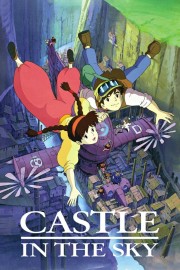Castle in the Sky
**This piece was written during the 2023 WGA and SAG-AFTRA strikes. Without the labor of the writers and actors currently on strike, the movies being covered here wouldn’t exist.
Hayao Miyazaki is probably the most empathetic filmmaker of all-time. Apart from his visual imagination, what stands out the most about his films is how he cares about his characters, and shows them as unique beings, with their own emotional journeys to take. Some may take paths of destruction when faced with power, but we never fail to understand the whys of their actions- we just wish they had chosen a different path. “Castle in the Sky” is a great example of this, a film which follows several characters, all of whom are connected by the hopes of seeing Laputa, a floating kingdom of myth and legend. Like many Miyazaki films, it starts with children.
I’m fairly certain I watched this film several years ago, and I’ll admit- I kind of bounced off of it. I don’t think I was as familiar with the rhythms and aims of his storytelling as I am now; now, after seeing some of his other films from that time in addition to the films of the past 25 years that made me adore him, “Castle in the Sky” started a bit slow, but by the time Pazu and Sheeta go off with the pirates to find Laputa, I was fully on board, and when they get to Laputa, I am waiting anxiously for what will happen next, even though it will likely involve the corruptibility of mankind being destroyed by nature, because that’s very much Miyazaki’s thing.
The film begins on a flying craft. Sheeta, a young girl, and her caretaker are being hunted by both the military and pirates. She escapes them, and falls to Earth. She has a gem around her neck that glows, and helps her fall carefully, right into the life of Pazu, a young boy eager to help her. Chases involving pirates and the military and flying ships and trains commence, and along the way we learn that Sheeta is a descendant of the great leaders of Laputa, a fabled sky kingdom, and the gem is an heirloom, of sorts. Pazu’s father once encountered Laputa, and Pazu has always hoped to see it. Through circumstances, they will get their chance, but what secrets it holds could bring forth destruction, in the wrong hands.
Children are often the main characters in Miyazaki’s films, I think, because the great filmmaker finds in them optimism, and an open mind to the fantastical nature of the world that adults do not have. They are also not so easily corruptible as adults, whom can be driven by greed and the desire for power. That may sound like a black-and-white worldview, but in Miyazaki’s hands, it offers opportunities for unexpected characters to grow, and to show us how children are our most important resource as humanity, and how important it is for us to nurture them to make a better world. In “Castle in the Sky,” the unexpected growth comes from Dola, the mother who is head of the pirates. Her and her clan have very clear goals in finding Laputa- plunder its riches- but they also will be invaluable to Sheeta and Pazu as they try and get Sheeta to her home. On the other side, we can discern what the military wants in Laputa, especially the bureaucrat leading them, Muska, who has a secret of his own.
Miyazaki makes films to get lost in. His worlds may not work by the accepted laws of science, but that’s because for him, it’s more important his characters obey a moral code than a scientific sense of logic. I love the world of Laputa, the sense of absurdity in the flying structures we are shown, the robots that guard Laputa, and how its all emotionally grounded by Joe Hisaishi’s music. The characters are engaging, the world is beautiful, and the sense of fun is undeniable. If I did see this many years ago, I was very wrong about it, and I’m glad I can see that.










